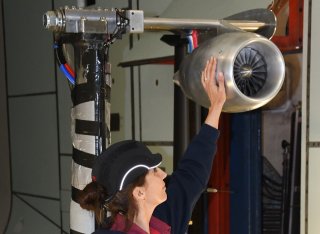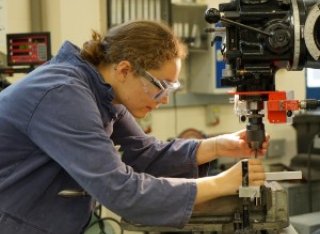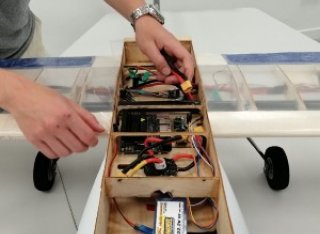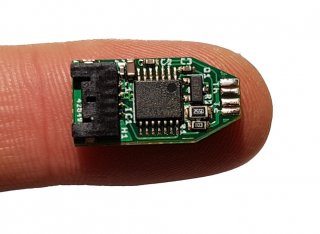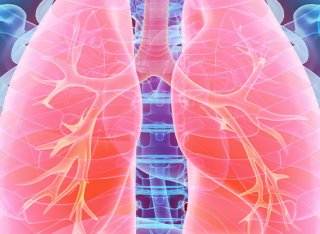
Dr David Birch
Academic and research departments
School of Mechanical Engineering Sciences, Centre for Aerodynamics, Aerospace and Automotive Engineering, Institute for Sustainability.About
Biography
Dr. David Birch is the head of the Centre for Aerodynamics, Aerospace & Automotive Engineering, the Director of Research at Surrey Sensors Ltd., a Sustainability Fellow at the Institute for Sustainability, and a Visiting Lecturer at Imperial College. Dr. Birch is a Chartered Engineer with more than twenty years of experience in experimental aerodynamics research, specializing in the characterization of highly vortical, unsteady turbulent flows and the development of the specialist instrumentation required for this work. Dr. Birch joined the University of Surrey in 2008.
Areas of specialism
University roles and responsibilities
- Head of Centre for Aerodynamics, Aerospace & Automotive Engineering
- Sustainability Fellow, Institute for Sustainability
My qualifications
Previous roles
News
In the media
ResearchResearch interests
Measurement and fluid metrology
Director of Research, Surrey Sensors Ltd.
- Sensor development
- Multi-sensor calibration techniques
- Measurement techniques and modelling
- Uncertainty characterisation
- Optimization
Fundamental turbulence research
- Turbulent vortex flows
- Turbulent boundary layer and channel flows
- Transport in turbulent flows
- Atmospheric flows and scalar dispersion
Current and recent research partners include
Research projects
This project aims to develop a major capital asset for the environmental flow community. A wind-tunnel model in the shape of a generic building is being constructed, fitted with some of the most advanced and sensitive flow measurement instruments currently available. With this model available, researchers working in areas such as wind flow around buildings, low-carbon ventillation and urban air quality will be able to get the much higher-quality, high-resolution data that is needed.
This project, a major collaboration between universities around the UK, was a response to the EPSRC's Future Cities grand challenge. It has brought together aerodynamicists, meteorologists, city planners, architects, mathematicians and others to address the problem of improving the urban environment in a low-carbon future. With work spanning simulation, wind-tunnel models and field measurements, this project has been one of the most comprehensive ever undertaken focusing on indoor and outdoor urban air quality.
Research interests
Measurement and fluid metrology
Director of Research, Surrey Sensors Ltd.
- Sensor development
- Multi-sensor calibration techniques
- Measurement techniques and modelling
- Uncertainty characterisation
- Optimization
Fundamental turbulence research
- Turbulent vortex flows
- Turbulent boundary layer and channel flows
- Transport in turbulent flows
- Atmospheric flows and scalar dispersion
Current and recent research partners include
Research projects
This project aims to develop a major capital asset for the environmental flow community. A wind-tunnel model in the shape of a generic building is being constructed, fitted with some of the most advanced and sensitive flow measurement instruments currently available. With this model available, researchers working in areas such as wind flow around buildings, low-carbon ventillation and urban air quality will be able to get the much higher-quality, high-resolution data that is needed.
This project, a major collaboration between universities around the UK, was a response to the EPSRC's Future Cities grand challenge. It has brought together aerodynamicists, meteorologists, city planners, architects, mathematicians and others to address the problem of improving the urban environment in a low-carbon future. With work spanning simulation, wind-tunnel models and field measurements, this project has been one of the most comprehensive ever undertaken focusing on indoor and outdoor urban air quality.
Teaching
Lecturing
I deliver components of the following undergraduate modules at the University of Surrey:
- ENG 1064 Design & Component Production
- ENG 1106 Mechanics
- ENG M249 Turbulence
I also deliver the following module as a Visiting Lecturer at Imperial College London
- AERO70003/96016 Advanced propulsion
Undergraduate supervision
I supervise students on the following undergraduate modules at the University of Surrey:
- ENG3163 Individual Project
- ENGM296 Advanced Research Project
I also supervise undergraduate project teams and undergraduate summer research students.
Postgraduate supervision
I supervise doctoral students on the Aerodynamics & Environmental Flow PhD programme.
Sustainable development goals
My research interests are related to the following:


Publications
A novel approach to correcting the effects of wall interference has been developed for closed-wall wind tunnels using a nonlinear least squares optimisation process that is independent of model geometry. Potential flow singularities are used to represent the test object and the method of images is used to represent the tunnel walls. The present approach makes use of trust-region reflective optimisation to allow the locations and strengths of singularities to be determined iteratively with only wall pressure measurements as independent inputs. The technique has been validated using CFD simulations of flow around canonical shapes in both free and wall-bounded conditions at blockages of 5 % to 20 %. Comparisons are drawn to the two-variable method, with demonstrated improvements across the range of bodies considered. A major source of error in wind tunnel testing arises from the interference effects between the wind tunnel walls and the test model. In a closed-wall tunnel, boundary layer growth along the walls results in a pressure gradient along the length of the tunnel referred to as horizontal buoyancy [1]-although the effects of this are typically mitigated through facility design. For a lifting model, the general redirection of the flow downwards is constrained by the tunnel floor, resulting in an induced upwash known as lift interference. The walls also impose a flow constraint in the region around the model and its wake, causing a local increase in streamwise velocity, affecting the aerodynamic forces and moments experienced by the model. It is imperative that wind tunnel test data be corrected for these effects, as aircraft design demands very low uncertainty from wind tunnel data [2]. One of the most widely-used correction techniques in wind tunnel testing is the two-variable (2V) method [3]. By defining a control volume bounded by the tunnel walls and by arbitrary upstream and downstream planes, the strength of all sources and sinks representing the tunnel walls can be obtained from the potential flux using the divergence theorem. To obtain a unique solution, two independent flow variables at the bounding surface are needed: for closed wall tunnels this may be taken as the streamwise velocity, and wall-normal velocity equal to zero due to the assumed imper-meability of the walls. The key advantage of this technique is that it can determine the interference flow field independently of any model representation. However, in order to do this, this technique normally requires a large number of wall pressure measurements (typically n ≈ 100) in order to obtain a sufficiently resolved solution. Contrary to the approach taken by the 2V method, the wall pressure signature technique provides estimates of the interference flow field by modelling the object in the wind tunnel and its wake as the superposition of source, sink and doublet elements centrally located along the tunnel axis [4]. This technique has the advantage of requiring significantly fewer measurements to obtain a unique solution (typically, n ≲ 20 [5]). However, the wall pressure-signature technique does not capture upwash corrections particularly well, as the blockage is assumed to be axisymmetric. The technique
A dynamic calibration facility and methodology was developed for use with high-precision, ultra-low-range pressure sensors. The facility was then validated, the effects of selection of forcing funciton were assessed, and the 500-channel Smart Cube model was dynamically calibrated for use in the EnFlo wind tunnel. This data set includes the output of these tests. See included README file for details.
Measuring surface pressures in a low-speed wind tunnel which are well-resolved in both space and time can be particularly challenging. A technique has therefore been developed for the simultaneous dynamic calibration of large numbers of pressure tappings on a wind tunnel model. A portable, variable-volume plenum is used to calibrate the model in situ. A forcing function consisting of sequential sinusoids at varying frequencies is used to obtain the spectral responses, with feedback control implemented to ensure consistent amplitudes independent of the plenum's own dynamics. This discrete calibration technique is shown to significantly reduce uncertainty propagation compared to white noise, chirp or step functions. The effectiveness of the dynamic calibration is validated against laser diagnostics in turbulent flow. As a demonstration of the capability of this technique, spatially-resolved surface pressure statistics are then presented for the five wetted faces of a cube in an atmospheric wind tunnel turbulent boundary layer.
A novel three-dimensional technique for correcting wind tunnel measurements for wall interference has been developed. The flow around the test body and its wake is approximated as a series of inviscid singularities, while the wind tunnel walls and model support are approximated using a panel method. A nonlinear least-squares approach with trust-region reflective optimization is then used to obtain the strength and locations of singularities together with the domain boundary panel strengths by fitting to measured wall pressures. The technique is demonstrated using computational fluid dynamics for the test case of a well-documented slender delta wing body with high blockage and validated against both experiments and legacy data. The nonlinear least-squares wall correction method is shown to demonstrate a significant improvement in wall corrections compared to the classical two-variable technique.
A novel approach to correcting the effects of wall interference has been developed for low-speed closed-wall wind tunnels using a nonlinear least-squares optimization process independent of the model geometry. Potential flow singularities are used to represent the test object, and the method of images is used to represent the tunnel walls. Trust-region reflective optimization enables the locations and strengths of singularities to be determined iteratively with only wall pressure measurements as independent inputs. Results are obtained from a range of two-dimensional and three-dimensional airfoil test cases using both computational fluid dynamics simulations and wind tunnel experiments, including a NACA 0012 with deployed spoiler, a NACA 0015, a NACA 4415, and a McDonnell Douglas 30P30N high-lift configuration. The nonlinear least-squares wall-correction method is shown to demonstrate a considerable improvement over the conventional two-variable technique.
Research under the Managing Air for Green Inner Cities (MAGIC) project uses measurements and modelling to investigate the connections between external and internal conditions: the impact of urban airflow on the natural ventilation of a building. The test site was chosen so that under different environmental conditions the levels of external pollutants entering the building, from either a polluted road or a relatively clean courtyard, would be significantly different. Measurements included temperature, relative humidity, local wind and solar radiation, together with levels of carbon monoxide (CO) and carbon dioxide (CO2) both inside and outside the building to assess the indoor–outdoor exchange flows. Building ventilation took place through windows on two sides, allowing for single-sided and crosswind-driven ventilation, and also stack-driven ventilation in low wind conditions. The external flow around the test site was modelled in an urban boundary layer in a wind tunnel. The wind tunnel results were incorporated in a large-eddy-simulation model, Fluidity, and the results compared with monitoring data taken both within the building and from the surrounding area. In particular, the effects of street layout and associated street canyons, of roof geometry and the wakes of nearby tall buildings were examined.
The calibration of directional velocity probes can require significant facility time and resources, especially if carried out in situ. The techniques of design of experiments are therefore applied in order to formally optimize the selection of calibration points. A model is proposed for a generalized directional velocity probe, and this model is used to generate an approximate, polynomial response surface model which is shown to agree well with measurements from both multi-sensor hot-wire probes and multi-hole pressure probes, in a variety of geometries. The process of D-optimality is then applied based on this response surface model, and a typical probe is calibrated accordingly. The probe is then used to scan the wake of a vortex generator, in order to test the efficacy of the reduced calibrations. D-optimal calibration points are shown to offer a significant improvement in data fidelity over conventional rectangular grids, and minimal additional uncertainty is incurred after a 25-fold reduction in the number of calibration points.
As performance improvements of compressors become more difficult to obtain, the optimization of stator well structure to control the reverse leakage flow is a more important research subject. Normally, the stator well can be considered as two rotor–stator cavities linked by the labyrinth seal. The flow with high tangential velocity and high total temperature exited from the stator well interacts with the main flow, which can affect the compressor aerodynamic performance. Based on the flow mechanisms in the basic stator well, four geometries were proposed and studied. For geometry a and geometry b, seal lips were attached to the rotor and stator inside downstream rim seal while impellers were positioned in the cavities for geometry c and geometry d. Leakage flow rates, tangential velocities, and pressure distributions in the cavities were analyzed using validated method of computational fluid dynamics. In the current study, where ω = 8000 rpm, π = 1.05–1.30, the maximum reductions of leakage flow rate for geometry a and geometry b are 7.9% and 15.9%, respectively, compared to the baseline model. In addition, the rotating impellers in the downstream cavity for geometry c contribute to a more significant pressure gradient along radial direction, reducing the leakage flow as much as 46%. Although the stationary impellers in the upstream cavity for geometry d appear to have little effect upon the leakage, these impellers can be used to adjust the tangential velocity of ejected flow from the stator well to the mainstream.
A flow meter (1) comprising a sampling tube (3) through which fluid may flow and a sensor arrangement (9, 25, 27, 39, 41, 43, 44, 45, 46, 47), wherein the sampling tube (3) comprises a first hollow section (51, 53) having a first internal cross-sectional area (A1) and a second hollow section (55, 57) having a second internal cross-sectional area (A2) being less than the first internal cross-sectional area (A1); and the sensor arrangement (9, 25, 27, 39, 41, 43, 44, 45, 46, 47), is for measuring the difference between stagnation and static pressures (P01, P02, P1, P2) within the second hollow section (55, 57).
A technique has been developed to compensate pressure readings from arrays of highly sensitive membrane-type pressure sensors for deflections caused by acceleration normal to the plane of the membrane using a single inertial measurement unit. By normalizing the fourth-order unsteady Kirchoff-Love equation, it can be shown that inertial body pseudoforces and applied surface pressure elicit a similar and additive response from the sensors. Inertial effects arising from linear and angular acceleration as well as angular velocity may therefore be converted to 'pseudopressures' and eliminated by means of a simple linear compensation process which can be calibrated using only gravity. To demonstrate, signals from a conventional six-axis inertial measurement unit (including three orthogonal components each of angular velocity and linear acceleration) are used to provide an approximation of the acceleration of the sensing dies within a seven-channel distributed array of ultra-low pressure sensors. Applying the proposed correction reduces the maximum full-scale uncertainty of the measurements by as much as 50%.
The measurement of vortex flows with particle-image velocimetry (PIV) is particularly susceptible to error arising from the finite mass of the tracer particles, owing to the high velocities and accelerations typically experienced. A classical model of Stokes-flow particle transport is adopted, and an approximate solution for the case of particle transport within an axisymmetric, quasi-two-dimensional Batchelor q-vortex is presented. A generalized expression for the maximum particle tracking error is proposed for each of the velocity components, and the importance of finite particle size distributions is discussed. The results indicate that the tangential velocity component is significantly less sensitive to tracking error than the radial component, and that the conventional particle selection criterion (based on the particle Stokes number) may result in either over- or under-sized particles for a specified allowable error bound. Results were demonstrated by means of PIV measurements carried out in air and water using particles with very different properties.
A direct numerical simulation of a Batchelor vortex has been carried out in the presence of freely-decaying turbulence, using both periodic and symmetric boundary conditions; the latter most closely approximates typical experimental conditions, while the former is often used in computational simulations for the purposes of numerical convenience. The higher-order velocity statistics were shown to be strongly dependent upon the boundary conditions, but the dependence could be mostly eliminated by correcting for the random, Gaussian modulation of the vortex trajectory commonly referred to as 'wandering' using a technique often employed in the analysis of experimental data. Once corrected for this wandering, the strong peaks in the Reynolds stresses normally observed at the vortex centre were replaced by smaller local extrema located within the core region but away from the centre. The distributions of the corrected Reynolds stresses suggested that the formation and organization of secondary structures within the core is the main mechanism in turbulent production during the linear growth phase of vortex development.
Trailing vortices have been repeatedly shown to exhibit a remarkably robust self-similarity independent of the Reynolds number and upstream boundary conditions. The collapse of the inner-scaled circulation profiles of a trailing vortex has even been previously demonstrated for the cases of highly unsteady and turbulent vortex systems, as well as for vortices which were incompletely developed. A number of factors which contribute to and may artificially promote this self-similarity are discussed. It is shown that the amplitude of vortex “wandering” (or the random modulations in the vortex trajectory) observed in some experimental measurements are of sufficient amplitude to cause any arbitrary finite and axisymmetric flow structure to collapse with an idealized trailing vortex when scaled on inner parameters. It is further shown that, for the case of an incompletely developed wing-tip vortex, similarity in the outer core region may be an artefact of the rate of roll-up of the vortex sheet. Great care must, therefore, be taken when interpreting experimental measurements of vortex flows.
The streamwise velocity component in fully-developed turbulent channel flow is studied for two very rough surfaces and a smooth surface at comparable Reynolds numbers. One rough surface comprises sparse and isotropic grit with a non-Gaussian distribution. The other is a uniform mesh consisting of twisted rectangular elements which form a diamond pattern. The mean roughness heights (± the standard deviation) are, respectively, about 76 ± 42 and 145 ± 150 wall units. The mean velocity profile over the grit surface exhibits self-similarity (in the form of a logarithmic law) within the limited range of 0:03 ≤ y/h ≤ 0.05, but the profile over the mesh surface exhibits only a small region with a slope tangential to log-law slope scaled on outer variables. However, the mean velocity deficit and higher moments (up to the fourth order) all exhibit some degree of outer scaling over both surfaces. The distinction between self-similarity and outer similarity is clarified and the importance of the former is explained. Spatial correlations show that the dominant large-scale features are very large quasi-streamwise structures with circulation in the cross-flow plane, similar to those found in smooth-wall internal and external flows. However, in the present case, the spanwise length scales are considerably larger. © Springer Science+Business Media B.V. 2010.
Proceedings of the IUTAM Symposium held at the Royal Geographical Society, 19-22 September 2006, hosted by Imperial College, London, England.
A two-component micropillar system has been developed for use in flow characterization and control applications. It is demonstrated that the piezoresistive elements in a conventional pressure sensing die can be used to measure moments directly applied to the die with reasonable sensitivity. The concept is then demonstrated by bonding a small, rigid pillar to the centre of a commercially-available, off-the-shelf doped silicon pressure sensing membrane with integrated piezoresistive bridge elements. The signal response of the system is then calibrated against aerodynamic loading, and a typical sensitivity of 70 mV/mNm is demonstrated. The functionality of the micropillars in flow control applications is verified by recessing the pillar below a flat surface on which a model boundary layer is developed. By processing the signals through the membrane bridge-arms independently, directionally-resolved forces may also be obtained.
A generalized calibration process is presented for multi-hole, pressure-based velocity probes which is independent of the number of holes and probe geometry, allowing the use of probes with large numbers of holes. The calibration algorithm is demonstrated at low speeds with a conventional seven-hole pressure probe and a novel nineteen-hole pressure probe. Because the calibration algorithm is independent of probe configuration, it is very tolerant of data corruption and imperfections in the probe tip geometry. The advantages of using probes with large numbers of holes is demonstrated in a conventional wing wake survey. The nineteen-hole probe offers a higher angular sensitivity than a conventional seven-hole probe, and can accurately measure velocity components even when an analytical calibration scheme is used. The probe can also provide local estimates of the diagonal components of the cross-flow velocity gradient tensor in highly vortical flows.
For measuring three components of velocity in unknown flow fields, multi-hole pressure probes possess a significant advantage. Unlike methods such as hot-wire anemometry, laser-Doppler velocimetry and particle-image velocimetry, multi-hole pressure probes can provide not only the three components of local velocity, but also static and stagnation pressures. However, multi-hole probes do require exhaustive calibration. The traditional technique for calibrating these probes is based on either look-up tables or polynomial curve fitting, but with the low cost and easy availability of powerful computing resources, neural networks are increasingly being used. Here, we explore the possibility to further reduce measurement uncertainty by implementing neural-network-based methods that have not been previously used for probe calibration, including supervised and unsupervised learning neural networks, regression models and elastic-map methods. We demonstrate that calibrating probes in this way can reduce the uncertainty in flow angularity by as much as 50% compared to conventional techniques.
The EMPAS collaborative project covered development and demonstration of an electric motor powered aero-engine simulator in the QinetiQ 5-metre wind-tunnel. As part of the project, the University of Surrey was responsible for background research and development of various flow measurement and system monitoring technologies, for use in the EMPAS windtunnel tests. Development of an integrated digital pressure rake system is presented, which has enabled assessment of duct flow characteristics and derivation of fan pressure ratio for the EMPAS system. A novel approach based on use of miniature, low cost microphones was developed, which successfully provided in-situ fan RPM measurement and highlighted several promising areas for future monitoring of fan/system health. A 7-hole pressure probe was used to great effect for extensive flow-field surveys, to investigate and validate the aerodynamic flow field effects associated with the aero-engine simulator. Wind-tunnel results from use of the microphone and 7-hole probe systems are analyzed and presented in detail.
The aerodynamic characteristics of an aft-body, in-line mounted, boundary layer ingesting, electric ducted fan, propulsion installation system has been investigated through experimental and computational analysis. A modular wind-tunnel model allows variation in the geometry of the propulsion installation system to be assessed, in combination with fan speed. Various experimental measurement techniques, including LDA, seven-hole-probe and surface pressures are employed. The propulsion installation system has also been investigated using RANS CFD and comparison with experimental data is presented. An investigation of the boundary conditions for efficiently representing the fan in CFD is described. Initial results show reasonably good agreement between CFD and experiment, in terms of velocity profiles and surface pressures, but highlight remaining differences for cases exhibiting flow separation.
A novel approach has been considered for the formal process of calibrating multiple hole pressure probes for use in wind tunnels. Rather than determining the attitude angles of a probe and subsequently flow angularity for a fixed probe, either by linear interpolation between sample points or through the use of piecewise functional fits, the outputs from the probe are mapped as continuous functions across the angular test space, using a set of sample points derived from Optimal Design of Experiments. This offers the potential of more accurate probe calibrations across a wider range of flow onset angles, with fewer sample points than currently used for the same purpose. Proof-of-concept tests using a five-hole probe have indicated that the approach is viable, while examination of fits to legacy data from prior tests indicates that the approach is easily extendable to probes with an arbitrary number of holes, and to multiple hot-wire installations.
A constant-temperature anemometer has been developed which uses a single high-fidelity speaker driver as a combined signal and power amplifier. Owing to its small size and simplicity of construction, the anemometer is well suited for applications requiring a large number of channels (such as hot-wire rakes) as well as applications requiring the embedding of instrumentation within confined experimental models (such as reduced-scale wind turbine blades). The anemometer is shown to have performance characteristics similar to those of a commercial anemometer when used under its design conditions. An operating bandwidth as high as 10 kHz can be achieved, which is greater than most available time-resolved digital particle-image velocimetry systems and is shown to be sufficient to track large-scale turbulence structures in channel flow.
The streamwise velocity component is studied in fully-developed turbulent channel flow for two very rough surfaces and a smooth surface at comparable Reynolds numbers. One rough surface comprises sparse and isotropic grit with a highly non-Gaussian distribution. The other is a uniform mesh consisting of twisted rectangular elements which form a diamond pattern. The mean roughness heights (+/- the standard deviation) are, respectively, about 76 (+/- 42) and 145 (+/- 150) wall units. The flow is shown to be two-dimensional and fully developed up to the fourth-order moment of velocity. The mean velocity profile over the grit surface exhibits self-similarity (in the form of a logarithmic law) within the limited range of 0.04 < y/h < 0.06, but the profile over the mesh surface does not, even though the mean velocity deficit and higher moments (up to the fourth order) all exhibit outer scaling over both surfaces. The distinction between self-similarity and outer similarity is clarified and the importance of the former is explained. The wake strength is shown to increase slightly over the grit surface but decrease over the mesh surface. The latter result is contrary to recent measurements in rough-wall boundary layers. Single- and two-point velocity correlations reveal the presence of large-scale streamwise structure with circulation in the plane orthogonal to the mean velocity. Spanwise correlation length scales are significantly larger than corresponding ones for both internal and external smooth-wall flows.
There has been much recent interest in the combined structural and aerodynamic properties of porous metal foams, but there does not yet appear to be a consensus on the aerodynamic behaviour of these foam materials. A comprehensive analytical and experimental study with special attention to scaling was carried out in order to examine the flow around cylinders coated with porous metal foam and characterize the effects upon the mechanisms governing shear layer separation, vortex shedding and wake formation. Results have yielded a correlation between the distance separating the detaching shear layers and the vorticity losses in the near-wake. It seems that it is the coating configuration, rather than geometry, that influences vortex shedding, and therefore foams affect the flow in a similar way as shrouds or bleeding systems.




